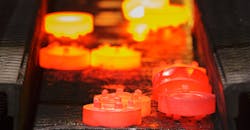Managing production technologies and harvesting performance data have brought a significant degree of cost savings to manufacturers, but forecasting and controlling energy costs remains beyond the complete definition of “control.” In particular for manufacturers like forgers, who must engage a range of energy types for even the most basic production processes, taking control of energy costs calls for expertise, or experience, as well as skill and information.
Three decades in manufacturing and one more directing continuous energy improvement programs has revealed to me every form of energy waste: Air compressors that run 24-7, even when there’s no work going on at the plant. Leaks that go unnoticed for days, weeks, or sometimes indefinitely. Used equipment that may have saved a few capital-investment dollars but drives up energy use. Does any of this sound familiar to you?
With the rise of continuous energy improvement programs, manufacturers are discovering that energy can make a significant impact on your productivity and bottom line. Some manufacturers save, on average, 20% after they adopt a CEI program. If you don’t yet have an energy management program, or can’t get your decision-makers to buy in, you can still find ways to move your plant in the right direction. Start small with these simple energy-saving opportunities to cut your utility costs today.
Identify, fix compressed-air leaks — You’ve heard of the “Dirty 30,” the last 30 feet of a line, where all the compressed air leaks happen. For nearly every manufacturing plant, compressed air leaks are the top source for energy waste. However, plant managers who are busy running teams and overseeing production often do not realize just how costly a compressed air leak can be. That one-quarter inch leak at 10 psi at 7 cents per kWh, for instance, could cost you $11,735 per year. But, if you reduce compressed air pressure by just 2 psi, you can cut your electrical use by 1% overall.
Make it a habit to identify leaks, repair them, and ensure they’re fixed with an ultrasonic leak tester. A general rule is that plants should aim for an 80-psi compressed air target. Also, remember that equipment isn’t measured for quality based on whether it leaks, so all new gear needs to be checked to make sure it’s leak-free.
Streamline idle time, changeovers — Idle time (downtime, changeovers) is one of the top energy wasters in manufacturing today. I’ve seen several instances where air compressors were running 24/7, and over weekends, to heat workspace. By simply reviewing the compressor operating schedule and running it only when needed, one plant saved 182,306 kWh -- or $18,230.
Start by determining your cost for idle time. Then, set a goal to reduce this cost and prioritize the equipment that provides the most energy savings. In one case, we worked with the sales departments to schedule product/pellet sizes and run durations. This allowed mixing products by size and avoid clearing the entire production line -- in turn, minimizing rework and changeover downtime. The result? Less energy waste, more available capacity and improved productivity.
Beware of used equipment — Maybe you think you go a great deal on some used equipment, but you probably didn’t take into account its energy cost. When including energy waste and use levels, it’s sometimes more cost effective to buy new equipment that’s designed better and produces better quality products.
Ask the “Energy Question” — When you’re trying to implement energy improvements, the worst thing to do is tell your organization that you’re starting a new initiative and seeking revolutionary ideas. Don’t reinvent the wheel. Instead, look at one of your successful programs and use that as a blueprint for your energy program.
If you have a lean manufacturing program, make energy an agenda item at your kaizen event. Ask the “energy question.” Integrate energy into your existing mapping process, and think about what it would look like to replace the words “safety” or “quality” with “energy” in your current programs.
The best way to save energy is to simply do it. One plant recently implemented a water reduction program called “Just Git ‘er Done” and achieved remarkable results by just saying they were going to get the job done. No big money spent, no formal program, but lots of signs and reader boards. This focused effort improved energy usage driven by pumping water and saved more than 1 million gallons of water.
Ed Birch is a principal with Strategic Energy Group, which is focused on strategic energy management implementations based on continuous improvement methodologies. Contact him via LinkedIn.
About the Author
Ed Birch
Principal
Ed Birch is a principal with Strategic Energy Group, which is focused on strategic energy management implementations based on continuous improvement methodologies. Contact him via LinkedIn.
